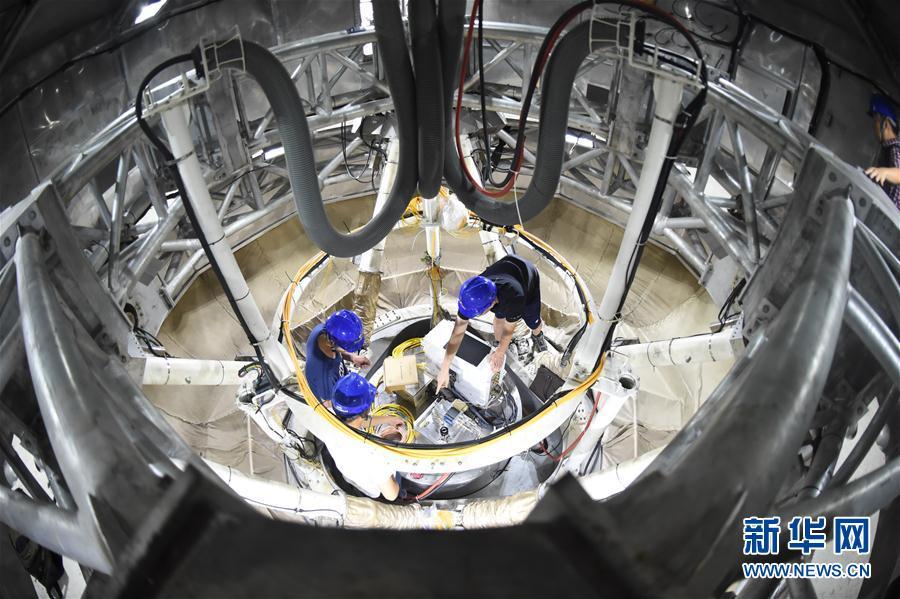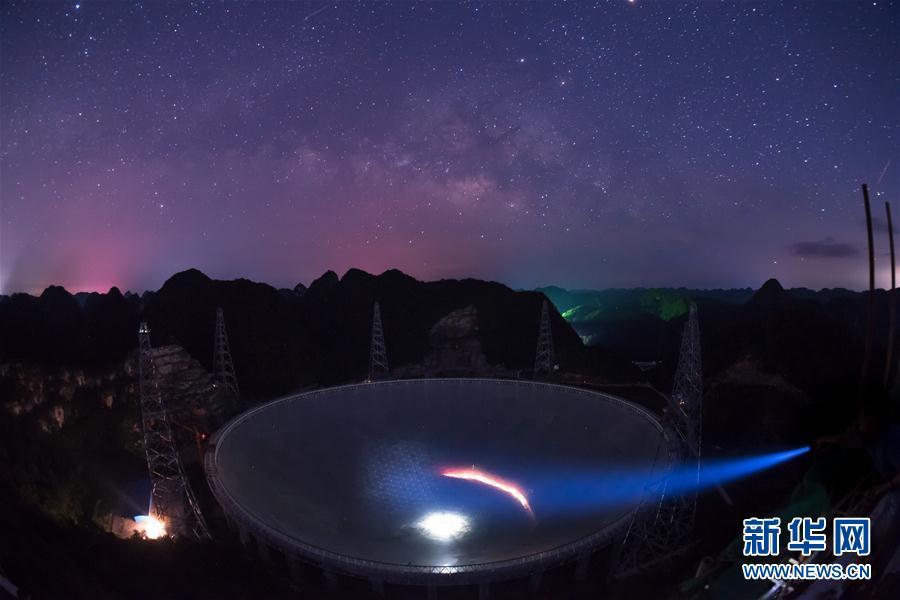What will "Five-hundred-meter Aperture Spherical Radio Telescope (FAST)" find in the future when he sees two pulsars with his eyes open?
Xinhua News Agency, Beijing, October 10th, by topicFive-hundred-meter Aperture Spherical Radio Telescope (FAST) opened his eyes and saw two pulsars. What will he find in the future?
Xinhua News Agency "Xinhua Viewpoint" reporter Dong Ruifeng and Qi Jian
4,100 light years, 16,000 light years. Five-hundred-meter Aperture Spherical Radio Telescope (FAST), located in the mountains of Guizhou, just opened its eyes and saw two pulsars so far away from the earth.
On the 10th, the National Astronomical Observatory of Chinese Academy of Sciences announced that after a year of intense debugging, the 500-meter spherical radio telescope (FAST) has realized the smooth operation of various observation modes such as pointing, tracking and drift scanning, and confirmed several newly discovered pulsars.

The pulsar family has the "China Star" for the first time.
This is the first time that China’s astronomical equipment has discovered pulsars and achieved a "zero breakthrough" in this field. Since the first pulsar was discovered in 1967, there have been at least 2,700 members of the pulsar family discovered by humans in the past 50 years.
The National Astronomical Observatory announced the specific information of these two pulsars: the former has a rotation period of 1.83 seconds, which is about 16,000 light years away from the Earth, and the latter has a rotation period of 0.59 seconds, which is about 4,100 light years away from the Earth. It was discovered by Five-hundred-meter Aperture Spherical Radio Telescope (FAST) on August 22 and 25 this year in galactic plane, South China.
This is only part of Five-hundred-meter Aperture Spherical Radio Telescope (FAST)’s discovery. Li Yong, deputy chief engineer of "Tianyan" project, said that the debugging progress of "Tianyan" has exceeded expectations. At present, dozens of high-quality pulsar candidates have been detected, of which 6 have passed international certification.
According to scientists, pulsar is a neutron star with high speed rotation, which is produced by star evolution and supernova explosion. Its density is extremely high, weighing hundreds of millions of tons per cubic centimeter, and the size of a cube of sugar is equivalent to the weight of 10 thousand tons of ships on the earth. Pulsar is the most accurate clock in the universe because of its fast rotation speed and accurate rotation period. Because of this, pulsars emit intermittent periodic pulse signals, just like a rotating lighthouse that emits flickering light.
This special "skill" makes pulsars have important applications in the fields of timing, gravitational wave detection, and general relativity testing. Li Yong said that pulsars have extreme physical properties that cannot be realized in ground laboratories, and studying them is expected to get answers to many major physical problems. For example, the rotation period of pulsars is extremely stable, and accurate clock signals provide an ideal tool for major scientific and technological applications such as gravitational wave detection and spacecraft navigation.
"By long-term monitoring of rapidly rotating radio pulsars and selecting a certain number of pulsars to form a timing array, we can detect low-frequency gravitational waves from celestial bodies such as supermassive double black holes." Li Wei said.
George Hobbs, scientific director of the Parkes telescope at the Australian Academy of Science and Industry, said that the debugging and gradual production of the "Eye of the Sky" is one of the most exciting events in the international astronomical community.

Debugging results in one year, comforting Nan Rendong, the "father of the Eye of the Sky"
The original idea of "Eye of the Sky" came from the late astronomer Nan Rendong. From the idea put forward in 1994 to the official opening in 2016, Nan Rendong and his team have been pushing this seemingly incredible world-class project with all their efforts for 22 years.
There is no precedent in design and structure, and the early debugging of "Eye of the Sky" encountered great difficulties. Wang Qiming, chief engineer of "Eye of the Sky" project, said that all systems focused on equipment tracking and maintenance at first, and the debugging in the system seemed to be all right. However, after the joint debugging of all systems, a series of problems such as communication between systems, algorithm unification and security coordination were gradually exposed.
During the joint debugging period, the working state of "Tianyan" people is basically to work separately during the day, concentrate on meetings at night, change procedures overnight, and then try new schemes the next day, and repeatedly adjust to the best. In the 380 days and nights after the completion of "Eye of the Sky", the main control room is always open 24 hours a day unless there is power failure. During the day, the engineering team and the construction personnel concentrate on debugging; At night, researchers will fix the surface shape so that it points to a specific sky area, and through the rotation of the earth, the sky will drift and scan over the telescope.
Li Yong said that the drift scanning method is rarely used in pulsar search, but it can only be used during debugging. For this reason, researchers not only need to redesign the software, but also have to pay more work in data processing, but the final result is exciting. "Eye of the Sky" can get one or two high-quality pulsar candidates every scan.
Peng bo, a researcher at the National Astronomical Observatory and deputy manager of the "Eye of the Sky" project, said that it usually takes three to five years to debug foreign similar large-scale radio telescopes, and the "Eye of the Sky" has achieved initial results after debugging for one year.
"Eye of the Sky" will look for "aliens" and will dominate the future cosmic sky map.
Chinese and foreign scientists are expecting the discovery of "Eye of the Sky" to change from quantitative change to qualitative change. If "Eye of the Sky" can be the first to capture pulsars of galaxies outside the river, it will be of groundbreaking significance. Li Yong and his research team are already making technical preparations for observing pulsars in extragalactic galaxies, and will try them as early as next year.
Jocelyn Bell, the first astronomer to discover pulsars, visited the Five-hundred-meter Aperture Spherical Radio Telescope (FAST) earlier this year. She expected the world’s largest radio telescope to discover more faint, distant and unique pulsars, including those revolving around black holes.
For the "Eye of the Sky" whose observation range can reach the edge of the known universe, the discovery of pulsars is only one of its missions. In the future, it will also shine in neutral hydrogen observation, spectral line observation and finding possible interstellar communication signals.
According to BIGBANG’s theory, neutral hydrogen is an "old man" who is almost the same age as the Big Bang in the universe. Observing and studying the distribution of neutral hydrogen can help scientists to further understand the structure of the Milky Way and extragalactic galaxies and solve the mystery of the origin and evolution of BIGBANG and other universes. "Five-hundred-meter Aperture Spherical Radio Telescope (FAST) will draw the latest and largest standard cosmic sky map by patrolling the neutral hydrogen in the universe." Marko Krco (Kyle), a senior postdoctoral fellow in the "Eye of the Sky" project of the National Astronomical Observatory, said.
"Five-hundred-meter Aperture Spherical Radio Telescope (FAST)" can even "monitor" the radio waves emitted by alien civilizations that may exist in the universe. George Hobbs, scientific director of the Parkes telescope at the Australian Academy of Science and Industry, said that 20% of the time of the Parkes telescope is currently allocated to "looking for aliens", but nothing has been found. "Five-hundred-meter Aperture Spherical Radio Telescope (FAST)" has seen further, and maybe there will be exciting news in the future.